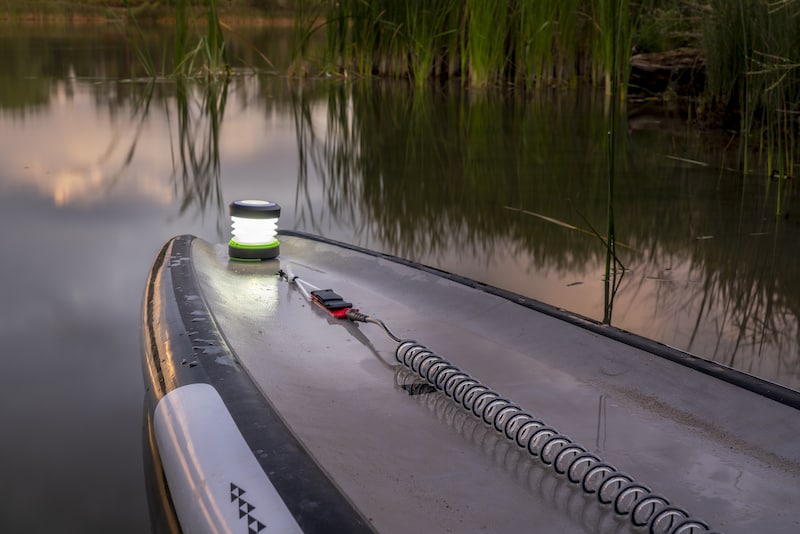Late-night paddles may seem like a crazy idea, but many kayakers enjoy an occasional nighttime outing. The stars on the water are magical, and city lights look spectacular. Fishermen enjoy night fishing when there are more bites and fewer boats on the water. In some parts of the world, kayak tours go out to spot bioluminescence.
But can it be done safely, and if so, how do you do it? Do you need to have a kayak light, if so what kind? Here’s a look at a few of the things you need to consider before heading out to kayak after dark.
Is Kayaking at Night Safe?

Kayaking at night isn’t inherently any more dangerous than during the day–so long as you apply a little common sense. The primary safety concerns are being seen by other boaters and the possibility of becoming disoriented.
You’ve got to make your vessel visible at night. There are some regulations to follow, but common sense is an even better guide. Never assume that another vessel is going to see you at night. You need to know if a vessel is headed towards you, and if it is coming towards you, you need to make yourself known. It’s not bad advice during the day, either, but it’s a lot easier to know whether or not you’re in danger during the day. It’s also a lot easier for other boaters to see you during the day.
Another concern is not getting lost. A night, you may not be able to see the landmarks you are used to during the day. Even if you’re in an area that is very familiar to you, everything looks different once the sun goes down. It’s easier than you might think to get disoriented on the water at night.
US Laws and Regulations
As with all watercraft, kayaks are regulated by the US Coast Guard and each state’s government. As such, you need to look up your state’s regulations to figure out what you need to have.
The Coast Guard considers a kayak a human-powered or oar-driven vessel. The regulations state that they should display the same lights as a sailboat or have available a torch or flashlight if unable.
You should note that if you are installing navigation lights on your kayak, they should be Coast Guard approved units. These have standardized brightness and colors, as well as precise arcs of visibility.
Don’t just read the regulations for kayaks and move on. Each type of vessel, like powerboats and sailboats, have slightly different lighting requirements. Learning what those lights mean will help you identify which direction a boat is headed and if they are a factor. This is how boaters navigate at night, and it’s how you should too.
Nearly all other vessels are required to display sidelights, with the red light showing on the port (left-hand) bow and the green light on the starboard (right-hand) bow. The stern light is always white. The colors can tell you which way a vessel is pointed. For example, if you see a red light, the vessel is crossing from your right to left. If you see both a red and green, the vessel is likely headed right for you.
Even though the regulations state that you may display an all-around white light, this is commonly known to boaters as the light of an anchored vessel. They will avoid it if they see it, but they also may be surprised to see someone out in the dark in a kayak. For this same reason, it’s essential to make sure that your kayak lights don’t conflict with other CG regulations, which might confuse boaters even more.
Kayak Lights

Most states require a kayak to have at least an all-around white light visible. It needs to be mounted on a pole, and the pole needs to be tall enough that the view of the light isn’t blocked from other vessels.
This requires quite a tall pole on a kayak since there isn’t any area above the paddler’s torso. If you mount a light right behind you, someone in front of your boat cannot see it. Getting the light up high also keeps it out of your eyes, which helps preserve your night vision.
The light you mount on your boat should be bright. Coast Guard-approved lights are visible for two or three nautical miles, depending on the boat’s size. Those small solar garden lights don’t cut it, as they are so dim as to be barely visible. You can buy one ready made or there are lots of guides on how to make a kayak light available if you fancy a project.
Another great way to make your vessel easy to see is to light it up from the inside or underneath. Thin-skinned plastic kayaks light up brightly if you place a flashlight inside the hull. If the entire hull is aglow, it’s pretty hard for other boaters to miss you.
Having a bright flashlight or spotlight is necessary, no matter what the rules specify. A spotlight that can get the attention of another boater is your greatest safety feature. The most significant danger you face on the water is from other boaters running into you. It’s vital to remember that you are hard to see, and other boaters may not be paying as much attention as they should be.
Kayak lights are often dim, and they often blend in with lights onshore. If you hear a boat approaching, you can shine a bright flashlight on your deck to show the other boat you are there. You can flash the light in their direction if they still seem to be coming closer. Use care, however, to not shine a bright light directly into other boaters’ eyes. Many new high-power LED flashlights have SOS and strobe modes, which are handy to have in an emergency.
Planning Your Route at Night
Trip planning at night only requires a little more forethought than planning daytime paddles. Most kayakers aren’t going on long treks in the dark. Instead, they are paddling in a small area, out to enjoy the stars on the water, catch some fish, or maybe see the city lights.
The cardinal rule should be to do everything you can to avoid boat traffic. Crossing busy channels shouldn’t be minimized at night. If you are going to go near marinas or channels, make sure you light up your kayak well with bright lights.
Just like daytime paddling, plan your trip based on the tides, currents, and winds. Make sure that it’s easy to come home. But also make sure that it’s easy to find your way back home. This is especially important if you’re paddling in a remote wilderness area, away from all other lights and landmarks. You might want to leave a reliable light on at your launch point. Of course, GPSs and phone apps help, but you should be ready in case they fail.
Other Night Kayaking Equipment You’ll Need
If you have a chart you need to read, or you need to organize yourself in the boat, a low-brightness headlamp is a handy item to have. Red lights are the least destructive to your night vision. The better you can treat your eyes by staying away from bright lights, the better you can see in the dark.
Bright headlamps are a mixed bag, however. They certainly should not replace your high-powered flashlight. They tend to be awkward to use and difficult to aim. Having them point everywhere you look means they move around a lot. It is easy to flash them in your companions’ faces or catch the reflection of your deck, ruining your night vision.
Warm Clothing
Remember that the air is cooler at night. Even if the temperature doesn’t seem that low, it will seem cooler with no sun beating down. You’ll want a jacket or sweater that you can put on easily if it gets chilly. You may also want something waterproof in case dew begins to settle on chilly nights. If you paddle where you need to wear lots of layers or a drysuit, add an extra layer for nighttime outings.
Other Safety Gear
It’s not a bad idea to equip your lifejacket with an emergency strobe light. They make PFD lights that will automatically come on when submerged. These might not be ideal for kayaking, as there is a high chance they could go off accidentally and then drain the batteries. A simple, bright, and waterproof strobe with fresh batteries is cheap insurance to know that your fellow paddlers or other boaters can see you at night if all other technology fails you.
If you’re a long way from civilization, consider taking a satellite messenger of some sort. With devices like the Garmin InReach or Spot messengers, you can communicate with friends and loved ones to let them know where you are and when you’ll be back. They also have an SOS feature. They work off the satellite network, so cellular service dead zones are a non-issue. You can also find emergency locators, EPIRBs or PLBs, at your local outfitters or marine store. These send a distress call with your GPS coordinates to the Coast Guard for you in an emergency, and they don’t have the monthly service fees that the messengers do.
Conclusion
Night kayaking is well worth the efforts. The best way to start is from a place you are very familiar with paddling during the day. That way, navigation is less challenging, and you can get a feel for what is different and what is not. Just make sure to be easily spotted by other boats and have a bright flashlight or two.
